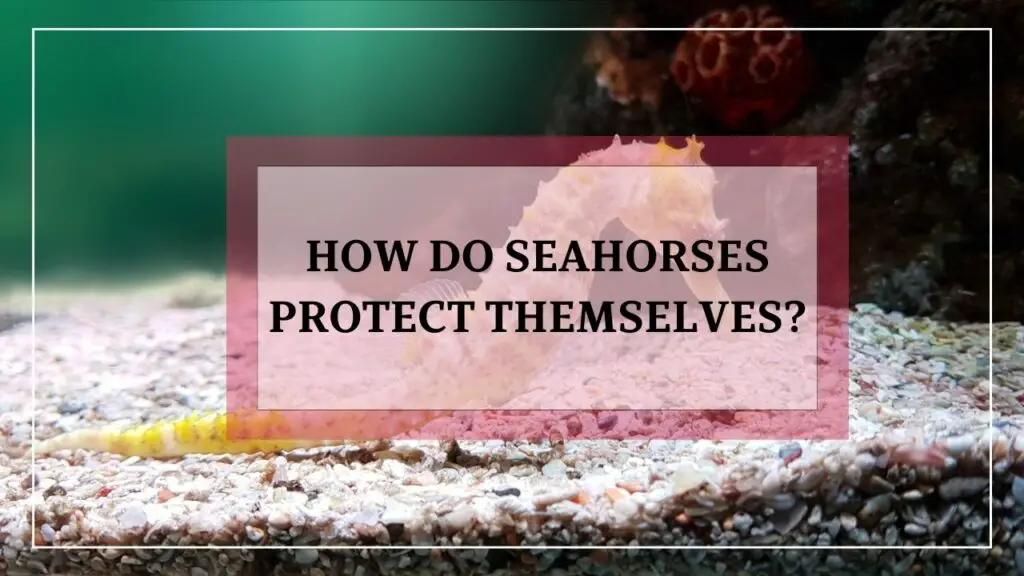Today, we’re diving deep to explore how these incredible creatures protect themselves in the vast marine realm.
Seahorses are more than just mystical creatures with captivating beauty; they possess an array of remarkable adaptations that ensure their safety in the ocean’s depths. From their intricate camouflaging abilities to their unique anatomical features, these enchanting creatures have developed ingenious ways to protect themselves from potential threats.
Seahorses protect themselves through various mechanisms such as camouflage, bony armor, small-size advantage, and powerful tails.
So, get ready to unravel the hidden world of seahorse self-defense! We will address each one of its self-defense mechanisms in a bit of detail:
Mastering the Art of Camouflage

Have you ever witnessed a seahorse effortlessly disappear before your eyes, leaving you in awe of its camouflage skills? Let’s learn about seahorses’ mastery of the art of blending in with their surroundings. It’s like they have their own little invisibility cloaks! Let’s uncover the secrets behind their remarkable camouflaging abilities.
Blending Seamlessly With Surroundings:
Picture this: you’re swimming in the vibrant underwater world, and suddenly, you spot a seahorse nestled among the corals or hiding amidst swaying seagrass. How do they do it? Well, seahorses are absolute masters of blending in. They possess a magical talent for seamlessly blending with their surroundings, making them incredibly difficult for predators to spot.
Pigment Cells And Their Role In Camouflaging:
The secret behind the seahorse’s camouflage lies within their skin. It’s not just ordinary skin; it’s a canvas for intricate artistry. Seahorses have pigment cells called chromatophores that are scattered throughout their bodies. These remarkable cells have the ability to expand or contract, allowing the seahorse to match the colors and textures of their environment.
So, when a seahorse finds itself amidst a bed of vibrant coral or a forest of swaying seagrass, its pigment cells go to work, morphing and adapting to mimic the surrounding hues. It’s like their skin becomes a living, ever-changing masterpiece, helping them seamlessly blend in and stay hidden from prying eyes.
Invisible To Predators:
The result of the seahorse’s camouflaging skills? Invisibility, or at least the next best thing! Their exceptional ability to match their environment makes them practically invisible to predators. It’s like they have a secret superpower that allows them to disappear when danger approaches.
By skillfully blending in, seahorses can avoid drawing attention to themselves. Predators searching for a quick snack are left perplexed, unable to locate these cunning creatures. It’s a game of hide-and-seek that the seahorse has mastered, ensuring its survival in the vast and sometimes perilous marine world.
Bony Armor: Shielding against Predators
We’re about to explore their unique defense mechanism: bony plates that make them as impenetrable as a fortress. These seahorses sure know how to rock the protective gear! Let’s delve into the fascinating world of seahorse bony armor.
Unique Bony Plates Instead Of Scales:
When it comes to protection, seahorses have taken a different approach compared to their scaly friends. Instead of the typical scales you see on most fish, seahorses have developed a one-of-a-kind defense system: a series of interconnected bony plates. It’s like they’ve decided to swap scales for something much more fashionable and formidable!
Dermal Plates As Protective Armor:
Imagine wearing a suit of armor that covers your entire body, shielding you from potential harm. That’s precisely what these seahorses have! Their bony plates, also known as dermal plates, act as protective armor. These plates are firmly connected, providing a rigid defense against would-be predators.
Seahorses wear their armor proudly, knowing that it gives them a significant advantage in the never-ending game of survival. Whether it’s lurking predators or curious creatures, these armored beauties can confidently face any danger that comes their way.
The Difficulty For Predators To Penetrate:
Now, imagine you’re a predator eyeing a seahorse as your next meal. You take a closer look and realize that this little creature is no easy target. Those bony plates create quite the challenge for any predator aiming to make a quick snack out of a seahorse.
The interconnected structure of the seahorse’s dermal plates makes it incredibly difficult for predators to penetrate their armor.
It’s like trying to crack open a walnut with bare hands – a tough nut to crack indeed! This armor provides the seahorse with a fighting chance, allowing it to evade capture and live to see another day.
Size Advantage: “Bigger” Isn’t Always Better
let’s talk about how size can sometimes be a superpower in the underwater realm of seahorses. You know what they say, “Good things come in small packages,” and seahorses are a perfect example of that! Their small size isn’t a disadvantage; it’s a clever defense strategy that helps them outsmart their larger counterparts. Let’s explore the mighty power of being tiny!
Small Size As A Defense Mechanism:
When it comes to survival, seahorses have realized that being small has its perks. Their petite stature allows them to navigate through the nooks and crannies of their marine environment, finding hidden sanctuaries that larger predators struggle to reach. It’s like having a secret hideout that only the tiniest of creatures can access.
Think about it: while bigger fish draw attention with their grandiose presence, seahorses can discreetly slip into crevices, blending seamlessly with their surroundings. By remaining inconspicuous, these clever creatures can avoid the prying eyes of predators, making it much more challenging for them to become someone’s dinner.
Hiding In Nooks And Crannies:
Have you ever noticed how seahorses seem to magically disappear into the underwater landscape? Well, it’s not just their camouflaging skills at play; their small size enables them to squeeze into tight spaces that would be impossible for larger fish. It’s like they’re the Houdinis of the ocean, effortlessly vanishing from sight!
Seahorses seek refuge in the intricate nooks and crannies provided by coral reefs, seagrass beds, and other underwater structures. These hidden sanctuaries offer seahorses a safe haven, shielding them from prying eyes and potential predators. It’s like having your own secret spot where you can relax and enjoy the ocean view, undisturbed.
Avoiding Attention From Predators:
Imagine you’re a predator on the prowl, searching for a delectable morsel. Your eyes scan the vibrant underwater world, but wait… where did that seahorse go? Well, my friend, that’s the beauty of being small and inconspicuous. Seahorses are masters at avoiding attention from predators.
Their petite size and unassuming nature help them fly under the radar, making them less likely to attract unwanted attention. While larger fish may be targeted by predators looking for a substantial meal, seahorses can swim undetected, enjoying their peaceful underwater existence.
Mighty Tails: Powerful and Protective
The incredible power of seahorse tails! These majestic creatures possess a secret weapon that not only helps them navigate through the underwater world but also provides a level of protection that is truly remarkable. Let’s dive into the importance of their mighty tails and uncover the hidden strengths within!
Importance Of Prehensile Tails:
Seahorses have tails that are nothing short of awe-inspiring. These appendages, known as prehensile tails, are like flexible extensions of their bodies, granting them a whole new level of control and maneuverability. It’s like having an extra set of hands or, in this case, an extra set of tails!
Gripping And Maneuvering:
Have you ever tried grabbing onto something using just your hands? Well, seahorses take it to the next level with their exceptional gripping abilities. Their prehensile tails can wrap around objects like seagrass, corals, or even the tail of their potential mate. It’s like having a built-in grappling hook!
This gripping power allows seahorses to stay anchored in place, even amidst strong currents. They can comfortably sway with the motion of the ocean, maintaining their position and conserving energy. It’s a skill that comes in handy when they need to remain in a safe spot or when they’re on a romantic rendezvous.
Anchoring To Resist Predators:
Now, imagine you’re a seahorse, and a sneaky predator is lurking nearby, eyeing you as a potential meal. What do you do? Well, seahorses have a clever trick up their tails. They can use their prehensile tails to anchor themselves to a secure structure, making it challenging for predators to snatch them away.
By firmly gripping onto a coral branch or a seagrass blade, seahorses can resist the relentless tug of predators trying to pull them off. It’s like a game of tug-of-war where the seahorse’s mighty tail becomes the ultimate anchor, preventing them from becoming a predator’s next snack.
Camouflaging and Courtship: The Ultimate Balancing Act
When it comes to romance, seahorses know how to make it truly enchanting. During courtship, both male and female seahorses engage in a mesmerizing display of color-changing and camouflage. It’s like a synchronized dance where they show off their vibrant hues and mimic their surroundings.
The seahorses’ camouflaging abilities play a vital role in courtship. By blending in with their environment, they create a safe and private space to perform their intricate courtship rituals. It’s like wearing a disguise, allowing them to express their love and affection without drawing unwanted attention.
Male Seahorses As Caregivers:
Now, here’s where things get even more interesting. In the world of seahorses, it’s the males who take on the role of caregivers and give birth to the next generation. Talk about breaking gender norms!
After a successful courtship, the female seahorse transfers her eggs into the male’s specialized pouch, where they are fertilized. The male then carries the eggs for the gestation period, providing them with a safe and nourishing environment. It’s like a father-to-be carrying the weight of future generations on his shoulders, or in this case, his pouch.
During this time, the male seahorse continues to camouflage himself, blending in with his surroundings to protect the precious cargo he carries. It’s a delicate balancing act of nurturing and camouflaging, ensuring the survival of the offspring.
Enhancing Reproductive Success through Camouflage:
The camouflage employed by seahorses during courtship and pregnancy serves a crucial purpose: enhancing their reproductive success. By blending in, they reduce the risk of attracting unwanted attention from predators. This camouflage allows the male seahorse to safely carry and protect the developing eggs until they are ready to hatch.
Additionally, the ability to camouflage during courtship helps seahorses establish strong bonds and select compatible mates. It’s like a mutual agreement to dance together in harmony, ensuring the survival of their offspring.
Conclusion
In conclusion, seahorses are true marvels of the underwater world, showcasing a variety of remarkable self-defense mechanisms. From their skillful camouflage and bony armor to their small size advantage and powerful tails, these enchanting creatures have honed their survival strategies to perfection.

Hi, I’m Ali Tarek, the founder of Animalsman. I’ve always been passionate about pets, especially dogs and cats, and I created this website to share practical tips, easy recipes, and helpful care advice for fellow pet lovers. My goal is to make pet care simple, enjoyable, and accessible for everyone. When I’m not writing or curating content, you’ll usually find me spending time with my furry friends or learning new ways to keep them happy and healthy.



